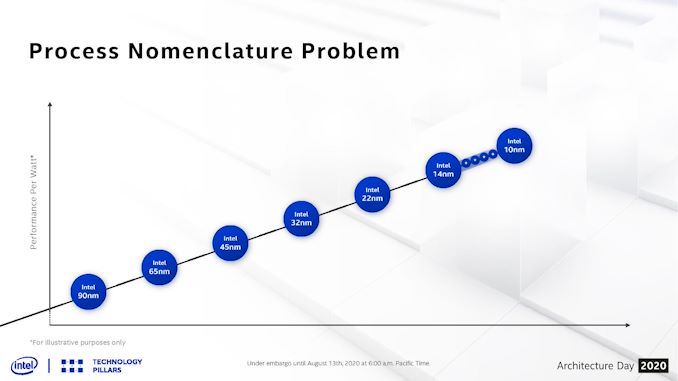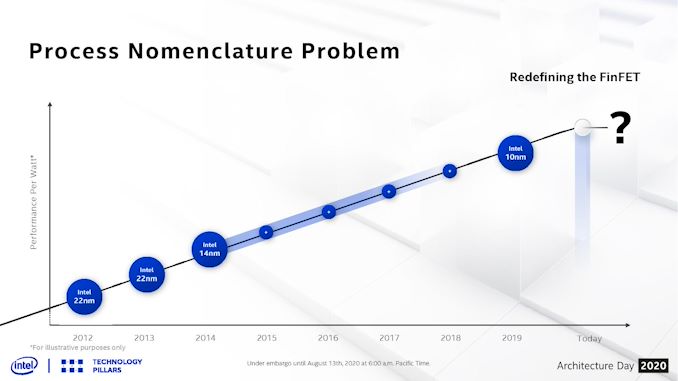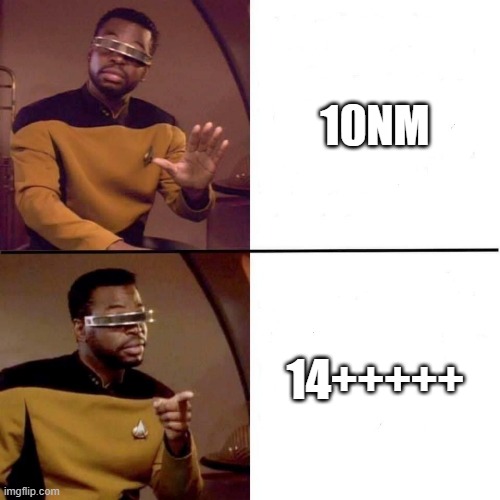What Products Use Intel 10nm? SuperFin and 10++ Demystified
by Dr. Ian Cutress on September 25, 2020 9:00 AM EST_678x452.jpg)
For our audience that regularly keeps track of Intel’s product portfolio, it would be hard to miss that the naming strategy of Intel’s process node technologies is a bit of a mess. To some, those words are themselves an understatement, as Intel has shifted its naming strategy 2-3 times since the launch of Intel’s first 10nm products. Not only that, even Intel’s various departments internally have a hard time keeping track of ‘what is this manufacturing process being called today’ when the press like AnandTech ask for details on the latest upcoming products.
Knowing this, and knowing what issues Intel has been having, I wanted to demystify Intel’s manufacturing process naming scheme such that users and engineers alike, even if they are inside Intel, can understand what is what but also importantly why. The why is the crucial factor.
If you're looking for a handy decoder ring for Intel's 10nm Products, it's here in page 3.
Why Do We Have Multiple Versions of a Process?
With Intel’s 14nm, we were invited to 14nm, 14+, 14++, 14+++, and if you believe Intel’s own slides, there were variants that went beyond this ++++ naming scheme. Each one of those additional + points on the end of the name signified a change in the process technology – usually to assist for increasing performance or efficiency.
Each one of these + points is an update to the BKM, or Best Known Methods.
While an engineer can draw an electrical layouts for a part of a processor, such as an addition circuit, actually applying that design to a silicon floorplan for manufacturing is a different skill altogether. Transistor libraries are designed to take advantage of a given process, and when a floorplan is optimized for a process, it can then be pasted and repeated as necessary – on top of this, simulation on thermals, power, and current density are applied to ensure that there are no hotspots or that critical paths inside the design have as few bottlenecks as possible.
When an update to the BKM occurs, two things can happen. Normally we see the update on the level of the transistor library that is changed – if the distance between two fins on a transistor increases for example, the transistor library and the macros may be made bigger, and then the floorplan might be redesigned to take account for this. As for any process node design, there are 100 different controls, and improving one might make three other controls worse, so it is a fine balancing act. Not only this, but the BKM has to be validated at the manufacturing level. The BKM update could apply to the metal stack as well, which in of itself can adjust the performance.
In the long long past, BKM updates were never advertised externally. If Intel or TSMC or another foundry discovered a way to improve the performance, or decrease the voltage, or improve the yield, the update was silently rolled into the design and nothing much was made of it. Sometimes processors would be listed as ‘1.0 volts to 1.35 volts’, and it would just be a roll of the dice if a user obtained one of the lower voltage models.
However, as time between different process node updates has elongated, these BKM updates have started to be identified and effectively monetized by the semiconductor companies. An update to a process that improves the voltage by 50 millivolts and increases frequency by 200 MHz immediately becomes a productizable event, and products built on these updates can be offered for more money over the usual. Or, depending on the rate of updates, the whole next generation of products could be built on the update.
So we never saw BKM updates officially announced at Intel’s 45nm, 32nm, or 22nm process nodes. These updates were fast enough that the productization of any update didn’t warrant a full round of marketing. With 14nm, that changed.
Intel had discussed its roadmap beyond 14nm since its 2010 Investor Meeting. It predicted that the company would be on 14nm by 2013, 10nm by 2015, and 7nm by 2017. As we now know, 14nm was two years late, and 10nm was 2-4 years late. Because of the introduction of 10nm being delayed, Intel decided to productize its 14nm BKM updates, and signified those with + points.
Intel’s current official line is that there have been four updates to 14nm, creating five ‘generations’.
More Plus Means More Meme
Because of all the + points, Intel’s marketing sometimes getting it wrong, and perhaps a little bit of ‘++’ in most programming languages meaning ‘+1’, the whole concept of adding + to the process node has become a meme – a meme at Intel’s expense, purely on the basis of its failure to deliver 10nm before the 14++++ naming scheme got out of hand.














143 Comments
View All Comments
Luminar - Saturday, September 26, 2020 - link
The wildfires were a result of AMD sabotage. Someone tried benchmarking his FX-8350 and R9 290x build.Spunjji - Monday, September 28, 2020 - link
😂eastcoast_pete - Saturday, September 26, 2020 - link
I hope Ryan is okay (health- and otherwise)! I actually got a bit concerned - this launch is a classic "Ryan does a deep dive review" moment. Or, did you guys at AT get on Jensen's sh#"list so they wouldn't send you review samples? But if, I can't see why that would be!Spunjji - Monday, September 28, 2020 - link
Yeah, I too am sad that we haven't received his insight on Ampere, as a lot of the content put out by other sites has left me wanting (and don't get me started on the YouTube soft-serve junk).On the flip side, I'm even more upset about how much of CA is on fire. 😫
watersb - Saturday, September 26, 2020 - link
Focus on the process node as a nominal feature size is over. Why can't we just let it go?This Tiger Lake bit, with SuperFin, would not be the same without that new capacitor design for the metal layer. A stack of materials, each layer on the order of three Ångstroms, that's nuts.
As long as we are fetishizing the light source wavelength or whatever, let's talk about the level of complexity that must be addressed.
So maybe Intel will not discuss design rules or validation protocols; that's intellectual property that they rely upon every bit as much as the frickin' ASML laser beams. Okay, you can't get them to comment, or provide slides, so not much to write about.
But we might at least entertain the notion that a godlike, perfect nano bot might well assemble some device at a 14nm scale that far exceeds what is considered possible in 2020.
davide445 - Saturday, September 26, 2020 - link
So much appreciating the inquisitive and specialistic work you are doing in Anandtech. The safe heaven I can always look at for objective unbiased analysis. Waiting for your Ampere GPU review.dontlistentome - Saturday, September 26, 2020 - link
Windows NT when it launched could support x86, DEC Alpha, MIPS and other CPU architectures transparently.If only they'd stuck with that - we'd have ARM laptops and desktops as a matter of course now, and Intel/AMD would have been a whole step forward than where they are with proper competition between competing instruction sets.
Alaa - Saturday, September 26, 2020 - link
Bloody hell!TheJian - Saturday, September 26, 2020 - link
"Intel ever wants to become a foundry player again."Funny, I thought they were basically running all fabs full steam (thus a player for a massively large portion of the market). Granted for a bit they will be using others (always have for some stuff) for some main launches now, but it is only until they right the fab ship and they have many ways to do that.
Acting like Intel is out of the game making 23.6B NET INCOME TTM is almost as bad as Ryan calling 1440p the enthusiast standard at 660ti launch...ROFLMAO. Go see the comments on that article to see how stupid his/j. Walton arguments were. Walton eventually resorted to name calling/personal attacks etc. I buried you guys with your OWN data...ROFL.
Oh, well, Intel's not a portal site here so...Yeah, I own the stock and wouldn't touch AMD with a 10ft pole if YOU were holding it. I said the slide was coming, we're 94 down to 77 now? A few more ~100mil Q's and people will take it back down to 30, and if they can't prove then a Billion/Q NET INCOME then they'll go way under that at some point.
That said, RAISE YOUR PRICES amd, so you can finally break 1B NET INCOME for a few quarters while owning some of the best cpus for years. If you don't break a billion in the next Q or two, you need to be bought, or CEO fired. NV just took back 9% share. Intel just had a record Q. You are doing nothing but hurting YOUR net income by not raising prices on very good product. Quit trying for cheap share, and start chasing RICH like NV/Intel. People buying parts under $250 on either side don't make you rich. Just stop consoles altogether and you'll have more R&D for stuff that makes more than 10-15% margins (consoles are made for $95-105 last gen, AMD made single digits for much of it, then mid teens, meaning 15% or less, or you'd say 16%). Consoles are why your cpu dropped out of the race for round1 (had to design 2 of those instead of cpus 7yrs ago or so) and gpu sucked all through the refresh etc. Timing is rough here, but you get the point.
They made a stupid bet on consoles dictating PC life, and well, NV said nope, and we listened to NV mostly :) You won't win with price if the other guy is kicking you perf wise. Richer people pay for perf, while the poor want that discount. That is the difference between an AMD Q report vs. Intel/NVDA. NV looks at possible margin and says, "consoles? ROFL. Whatever dude, I like making more on workstation/server and flagship desktops." Intel said the same and shafted celeron/pentium etc (poor people chips left 10% empty handed for ages) while moving wafers to high margin stuff (thus even losing on some sales, but still gaining revenue/income). Dump the cheap stuff when silicon is short (everywhere) and your enemy has good product. IE, fight only in stuff that makes highest margin(forget 8-15% crap like consoles - AMD said single digits early on, NOT ME).
AMDSuperFan - Saturday, September 26, 2020 - link
I think what you are missing is we enjoy playing AMD on our consoles very much. Who cares how much money a company makes. The market has spoken and said if AMD makes a billion a year, it is still as valuable as Intel or Nvidia. It is possible that in 20 or 30 years AMD might make that $23B that year and then you will feel very silly for saying the stock is not worth $30. I like AMD because of the 486DX4-120. It was faster than the DX3-100. I have been a fan ever since. Also, I liked ATI cards very much. Nvidia liked Voodoo2 cards and bought them for pennies on the dollar. AMD cards might be noisier and slower but they still are good for all the last generation games before Nvidia came out with their cheat of ray tracing technology. I still have a 7800 adapter which is quite fast for a lot of games. Even Diablo #2 is quite nice on it.So while you are talking money, I think John Carmack would approve of the AMD cards and processors of today. When AMD put 100 or 200 cores on a chip then people will know how serious they can be. Why would you want 8, 10, or even 16 ultra fast cores for computing, when you could have 200 cores to do more.
Also, I think it is good that AMD are putting people in Taiwan to work instead of always focusing their labor on Americans and Texans like they used to.